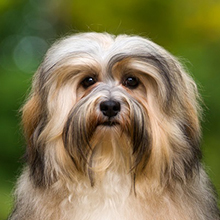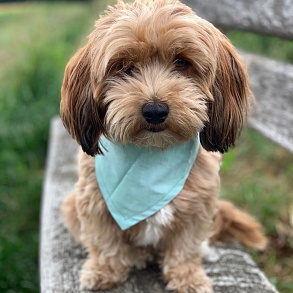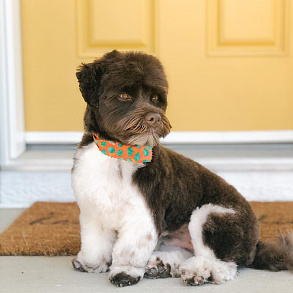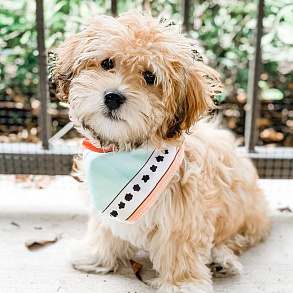Havana Bichon

The Havana Bichon is a sociable companion dog from a group of lapdogs with a smooth long coat.
Brief information
- Breed name: Havana Bichon
- Country of Origin: Cuba
- Weight: 3-5.5 kg
- Height (height at the withers): 23-29 cm
- Life expectancy: 13-15 years
Highlights
- The breed has the status of rare and exclusive. There is little information about it on Russian–language forums, and there are only a few domestic nurseries engaged in breeding purebred Havanese.
- The rarest color of the Havana bichon is white, the most common is tobacco.
- The trademark of the breed is phenomenal contact, so the Havanese are recommended for maintenance to people of retirement age, as well as owners suffering from loneliness and panic attacks.
- Bichons are easy to train, so even owners without experience with decorative dogs will be able to find contact with pets.
- Havana bichons are not cut, but you will still have to learn the basics of professional hair care – the animals have a weak molt, dead hairs need to be combed out.
- Loneliness, even for a few hours, is the strongest stress for the Havana bichon. Before you take a dog, think about who will brighten up her everyday life while you are at work.
- In the USA, havanese have a reputation as "signal" dogs, recommended as pets in families where there are hearing-impaired children.
Havana Bichon is a funny miniature cutie, capable of drowning in a sea of love and charm anyone who is ready to fondle him or scratch behind his ear. In Russian apartments, the Cuban Havanese is still a rare guest, but this does not mean that the breed is not quoted by breeders. Simply due to historical circumstances, the animals could not break through to exhibitions and to the breeding lists of cynological associations for a long time. Today, "havanets" is one of the most fashionable and exclusive pets in the world, the purchase of which will require not only a tidy sum, but also months of searching and waiting.
Breed characteristics
History of the Havanese breed
Havana bichons are the national dogs of Cuba, who began their triumphant march around the world from the Canary Islands. According to the official version, Cuban immigrants brought miniature pets to Europe. However, in fact, the reverse process took place. In the XVI century, Spanish navigators moved to the Island of Freedom, together with whom the first bichon-like dogs sailed there.
Gradually, crossing with native Cuban breeds, Spanish pets took shape into a unique breed type, which the locals dubbed the blanquito de la Abana – "little white dog from Havana". For several centuries, animals have been loved by the Cuban nobility. They were settled in rich chambers, pampered in every possible way and taken abroad as a living curiosity.
Unfortunately, the original type of blanquito de la Abana has not survived to this day. In many ways, the Cuban Revolution contributed to the disappearance of the amazing breed: in the second half of the XX century, dogs were massively exterminated simply because they were held in high esteem by the local aristocracy. As a result, out of the entire clan of Havana dogs, only a few individuals survived the change of the political regime, some of which were already mestizos.
There is an opinion that during the military events on Liberty Island, eleven blankitoes were smuggled from it to the USA. In any case, when American breeders began to promote the idea of restoring the breed, there were several healthy and relatively purebred producers in the country. In the 70s, the "Havanese" who lived in America were injected with the blood of other ornamental breeds, as a result of which the first representatives of the Havana bichon family were born.
If we are talking about the recognition of the breed by cynological associations, then it came to the Havanese only in 1996. In Russia, the first puppies appeared even later – it was only in the early 2000s that the first Cuban fuzzies began to be imported into the country. To this day, the number of domestic bichons is extremely small, which makes it difficult to choose a healthy and spectacular puppy in a show or breed type.
Video: Havana Bichon
The standard of the Havana Bichon breed
Havanez is a charming frisky hairy man who at first glance falls into the soul because of his spontaneity and comely appearance. The height of the average representative of the breed is 23-27 cm without reference to the floor. If you have a secret passion for "handbag" pets, get a Havana bichon without too much thought!
With an extensive palette of colors, these shaggy "Cubans" look like they just escaped from the red carpet, slipping out of the hands of a Hollywood diva. Actually, the glamorous exterior is half of the success of the breed, while the rest rightfully belongs to the companionable, non-malicious character of the "Havant".
Head
The length of Havanese's head is approximately ⅓ of the length of his body. The cranium can have both slightly rounded outlines and a flattened shape. If you look at the dog from the front or from the sides, then the skull gives the impression of a square, while the cheekbones are devoid of volume. The muzzle is not blunt and not narrowed, the stop is very light.
Teeth, lips, jaws
The jaws are scissor-shaped. It is desirable to have a complete dental formula, but the option when there are no third molars and first premolars is still acceptable. The lips of the Havana bichons are not fleshy, closely adjacent to the gums.
Nose
Neat lobe of black or brown color.
Eyes
Eyes in the form of large tonsils with a black or brown outline, as well as with a dark brown colored iris. The Havana bichon has a positive and friendly look.
Ears
The ears covered with spectacular feathering hang along the cheekbones and have a fold slightly lifting the ear cloth. The post is moderately high, the tips are rounded. Not touching the cheekbones or semi-erect ears are undesirable.
Neck
Havanese's neck has a moderate length, the skin is well stretched.
Housing
The body is strong, with an even and slightly convex back in the lower back. The croup is characterized by a strong slope, the abdomen is tightened, the ribs are distinguished by a good bend.
Limbs
The legs of the Havana bichon are distinguished by a strong backbone, parallel postage relative to each other and a general dryness of outline. An important caveat: the length of the forelimbs to the elbow should not exceed half the height of the dog at the withers. The paws are elongated, but compact, with tightly assembled fingers. The dog's movements are straightforward, springy and energetic.
Tail
The pedigreed Havanese has a tail thrown on its back or bent and carried high. The main decoration of this part of the body is a luxurious pendant made of long satin hair.
Wool
The undercoat of the Havana bichon is either absent as such, or poorly developed. The coat has a straight or slightly wavy structure and in mature individuals can reach a length of 12-18 cm . It is forbidden to shorten the dog's hair in any way. Exceptions are allowed for the fur on the paws and head, which can restrict movement and obscure the view.
Color
Traditional Havanese suits are white, white-biscuit, black, brown havana, fawn of any degree of saturation, sable, tobacco, red-brown. In all types of colors, white spots and a small tan are acceptable.
Disqualifying vices
- Height that does not fit within the limits set by the standard (deviations within 2 cm are acceptable).
- Overshot or undershot.
- Nose lobe with pronounced depigmentation.
- Entropy or ectropy. Depigmented eyelids.
- Any behavioral abnormalities, including unreasonable aggression and timidity.
- Cryptorchidism.
Character of the Havana Bichon
At heart, Havanese is a typical Cuban with his positively relaxed attitude to life and maniacal love of communication in any form. The sunny climate of Liberty Island and centuries of being in the status of an ornamental breed have formed a number of qualities in the Havana bichons that distinguish them from other miniature tribesmen. For example, for an unusual craving for constant contact with the owner of the "Havana" is often called Velcro. Walking on the heels, poking a curious nose into all the secrets of the family, periodically begging for affection and delicious rewards – all these are classic habits of the Havana bichon, without which he immediately ceases to be a true Cuban.
One of the highlights of the breed is the ability to mirror the behavior and mood of the owner. A dog of a cheerful and active owner is unlikely to be melancholic, and a pet of an emotionally restrained owner will quickly change his attitude to life. As for the traits of the breed as a whole, we can say that the Havana Bichon is a real tsunami of friendliness and tenderness. A furry friend is able to get along with any creature, arranging races with a dazed cat or taking part in funny adventures invented by the guys.
By the way, despite the external fluffiness and childish playfulness, havanese does not consider himself the last on the hierarchical ladder. This character trait is especially pronounced in everyday communication. In contact with the beloved owner, the dog always tries to climb somewhere - on a chair, someone's knees, or at least on an ottoman in the corner. All these manipulations are done with a single purpose - to be on the same level with a person. However, such attempts to gain authority should not be confused with attempts to dominate. Competition for leadership is something that the Havana bichons have never heard of and what they would never want to do.
The ringing, funny bark of the "Havants" can be an excellent substitute for a home alarm system. By its nature, the breed is not too "talkative", but it prefers to meet those who are not family members on the doorstep with a voice. The only nuance is that havanese will bark at your friends and intruders with the same unfriendly persistence, so it will not be possible to understand by intonation who exactly violated the territorial borders.
The secret passion of the breed is paper. It has not yet been possible to find out what exactly fuels this interest in animals, but leaving havanese alone with a pile of documents or a roll of toilet paper, prepare for local chaos and the subsequent collection of cellulose scraps in all corners of the apartment.
Education and training
It is better to take the training of the breed seriously, given that the Havanese are smart pets who can handle difficult educational tasks. The preparation of a puppy for upbringing and training is its socialization. Everything is simple here: the kid must get used to the new living conditions, get to know family members and learn to consider them the leaders of the pack. Remember that despite the absence of dominant habits, the "Habans" are rather cunning creatures who perceive any one–time concession as a pattern that must certainly repeat itself.
Discipline havanese from the very minutes as soon as you leave the kennel with him. In the first month after moving, the Havana bichon should get used to its bed, learn to perceive its own nickname and eat according to the regime established by the owner. It is better not to postpone the issue of "toilet matters" for later, so, of course, stock up on disposable diapers for the first time, but plant the puppy on the tray more often.
It is better to educate and train havanese at home, on a garden plot or in the yard. It is pointless to drive small representatives of ornamental breeds to the training ground. Playing on contrasts is also not encouraged. According to dog handlers, the whip method in the case of miniature dogs not only does not work, but also exposes their sensitive psyche to serious stress, so praise and treat your pet for success, and close your eyes to mistakes.
If you want havanese to respond to the call of all household members, enter the names of family members into his vocabulary. The standard technique is to put any small object in the teeth of the bichon, issuing the command "Take it to Sasha!" (the name of the person to whom the toy in the mouth is addressed is called). If the ward understood you and fulfilled the requirement, be sure to praise him, and then consolidate the new skill. Then start the training from the very beginning, but with the participation of another family member. Don't be surprised, the Havana bichon easily remembers human names, it just needs praise, treats and a moderately demanding teacher as a stimulating nourishment.
Havanese is not a service breed, monotonous classes are a burden to him. The time limit of training lessons for bichons is 5 minutes. For a longer concentration of attention on one action, the "Habans" are simply not capable. The same applies to teams. It is strongly not recommended to pronounce one requirement more than three times in a row. Remember, the more often you ask the dog, the less she wants to listen to you.
Maintenance and care
The Havana bichon spends most of his life in an apartment, so try to provide him with comfortable and safe living conditions. Think about how to exclude the pet's exit to the balcony – perhaps it will be a special grid or a high fence in front of the door. The same rule applies to household chemicals and a trash can in which the puppy can dig. Also eliminate the habit of leaving detergents on the floor, where the pet can taste them.
Havanese is an ideal dog for stay–at-home people. To dump the "energy load", he has enough runs on the territory of the infield or two half-hour walks a day. It is not recommended to "torture" the breed with exercises – the average Havana bichon is able to cover the need for physical activity with a simple jog in the company of the owner. By the way, in winter it is better to walk the dog dressed in insulated overalls. In frosty weather, bichons freeze quickly and can catch a cold. At the same time, in summer, UV protection is not required for dogs – their long soft and well-ventilated "fur coats" are reliable protection against overheating.
Hygiene
The Havana bichon is a living anti–stress toy that needs to be hugged, squeezed and, of course, combed out more often. Since the breed lacks an undercoat, the molt of its representatives is weakly pronounced, so you don't have to worry about the neatness of carpets and upholstery. This, however, does not mean that you can afford to be lazy with havanese. If you do not comb the dog's hair at least once a week, very soon you will have to arm yourself with a razor and remove woolen "dreadlocks" from the ward's body.
Bathing the descendants of the blankito is recommended only in case of urgent need, for example, when the animal looks untidy. Complex grooming of the breed is not required, but if you notice that the hair on the forehead has begun to obscure the dog's view, it is better to collect it in a ponytail or slightly shorten it with scissors. Once a month, give the ward a "pedicure", shortening the claws by a couple of millimeters. Since havanese do not suffer from excessive activity, their claw plate does not wear off when in contact with the ground. The first signal that it's time for the pet to cut its claws is a characteristic "clacking" gait.
Excessive lacrimation is a problem of the entire clan of Havana bichons, so often go through the eyelid area of the animal with a clean cloth soaked in strong chamomile or tea infusion. In white Havanese, the hair under the eyes often changes color from tears. Accordingly, if you are the owner of a blonde show pet, buy lightening talc and powder for wool.
It is better to inspect the ears of the "Cuban" once a week. Do not be lazy to pluck out the long hairs inside the dog's ear funnel, otherwise the passage will completely overgrown with wool, which will lead to deafness. You can remove sulfur lumps from your ears with a piece of clean cloth and a hygienic lotion from a pet store.
havanese is brushed 2-3 times a week. It is important to accustom the pet to this unpleasant process from puppy age. If the cleaning silicone nozzle causes severe stress in the dog, you can use pastes that are applied to the teeth without a brush. Or alternatively, treat the dog more often with solid meat treats that perform the function of a gentle abrasive.
Feeding
US breeders rely on high-quality dry food, motivating their choice by the fact that bichons eating "drying" do not need to additionally select vitamins and dietary supplements. There are no strict feeding standards for the breed, but on average an adult "Havana" absorbs from half to a whole cup of feed per day. If we make more accurate calculations, then an adult weighing 4.5 kg must receive at least 400 kcal per day with food. For playful puppies under the age of six months with a body weight of up to 3 kg, the daily calorie intake of the diet is 467 kcal.
At the same time, it is important to control the weight of the fluffy, since the breed tends to build up its sides. The signal that it's time for Havanese to go on a diet is an unexpressed waist (when looking at the dog from above) and non-palpable ribs. The frequency of feeding for healthy adults is twice a day. Puppies at the age of 6 months eat three times, but by the year they need to be transferred to two meals a day.
In Russia, Havana bichons are often fed natural food. The list of dog preferences usually includes all those products that are recommended for use by any breed. Namely: lean meat, giblets and offal, boneless fillet of cod fish, low-calorie cottage cheese and kefir, chicken yolk, vegetables (except legumes, cabbage and potatoes), fruits (grapes and exotic fruits are prohibited).
It is not necessary to give bichon cereal porridge to increase the nutritional value of a portion. This breed eats little, and does not expend much energy. Havanezam meat is cut into small pieces, serving it raw or slightly scalded. At the same time, it is important to understand that with this approach to nutrition, the purchase of ready-made vitamin and mineral complexes is an inevitable procedure. No matter how diverse the natural menu may be, it will not be possible to completely fill the body's need for minerals and trace elements with its help.
Health and diseases of Havanese
Havana bichons are long–lived dogs, often celebrating their own 14th and 16th anniversaries. Experts who monitor the development of the breed continue to work on the eradication of genetic diseases in its representatives, but so far hereditary ailments have not been completely defeated. For example, the most common problem of today's "Havans" is a dislocation of the kneecap. Diseases such as retinal dysplasia, cataracts, heart and liver pathologies, Perthes' disease, deafness, chondrodysplasia are also inherited.
How to choose a puppy
- The number of Havanese in Russia is still small, so pay great attention to the choice of a nursery. Alternatively, take a ride through the Baltic countries, where the breed began to be bred a little earlier.
- Try to communicate with the parent of the puppies and the rest of the babies in the litter. Pay attention to how the bichon you like behaves with his fellow tribesmen – he leads or obeys.
- Test the puppies for friendliness. Lift the little fuzzy off the floor and evaluate his actions. If the baby screams and tries to bite you, this is a sign of an unstable psyche. Remember, Havanese is not a "service man", and it is unusual for him to show aggression.
- Demand from the seller not only the pedigrees of the producers, but also the results of their examination for hereditary diseases. In particular, for dysplasia of the elbow and hip joint.
- Always attach importance to the appearance of the offspring. Puppies should be well-fed, with a clean smooth coat, without signs of umbilical hernia and traces of diarrhea under the tail. The uniformity of the litter is welcome, while one puppy will always be larger than the others.
The price of the Havana bichon
It is believed that the most promising havanese should be looked for in the USA, although American breeders are not eager to give abroad puppies with excellent exterior inclinations. As for the cost, it will not be possible to purchase a purebred Havana bichon in the States for less than $ 1000-1500. Havanese from Russian kennels are cheaper – from $300 for a pet-class puppy. It is better not to respond to offers with a lower price tag that are found on virtual bulletin boards. In most cases, they are placed by sellers of mestizos and animals without documents.


